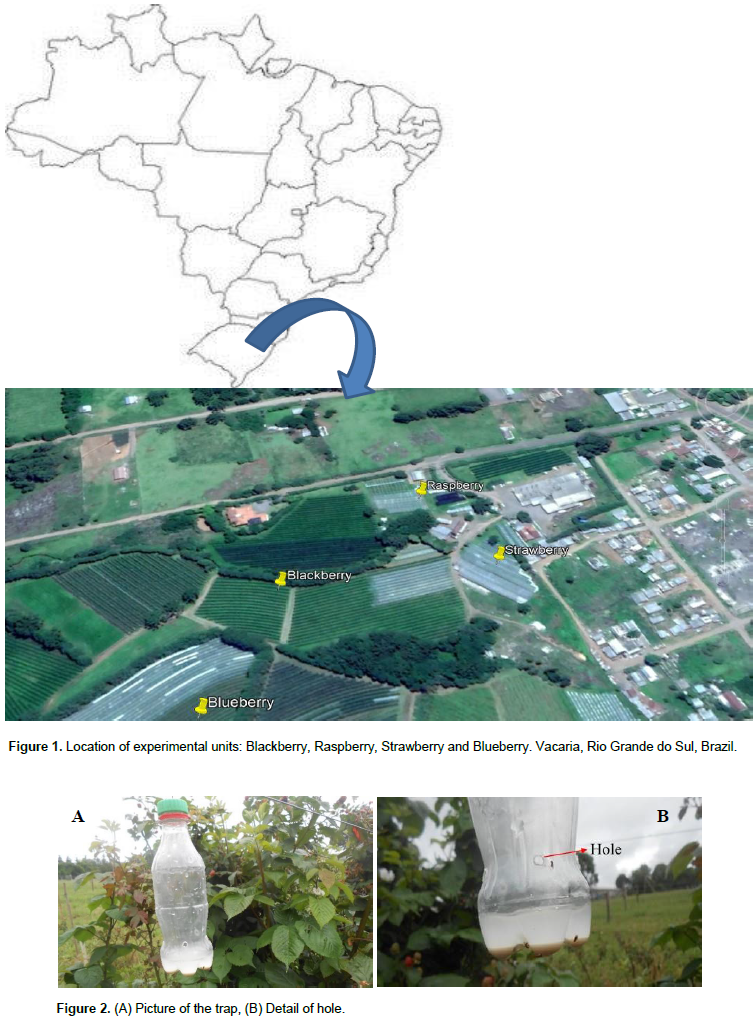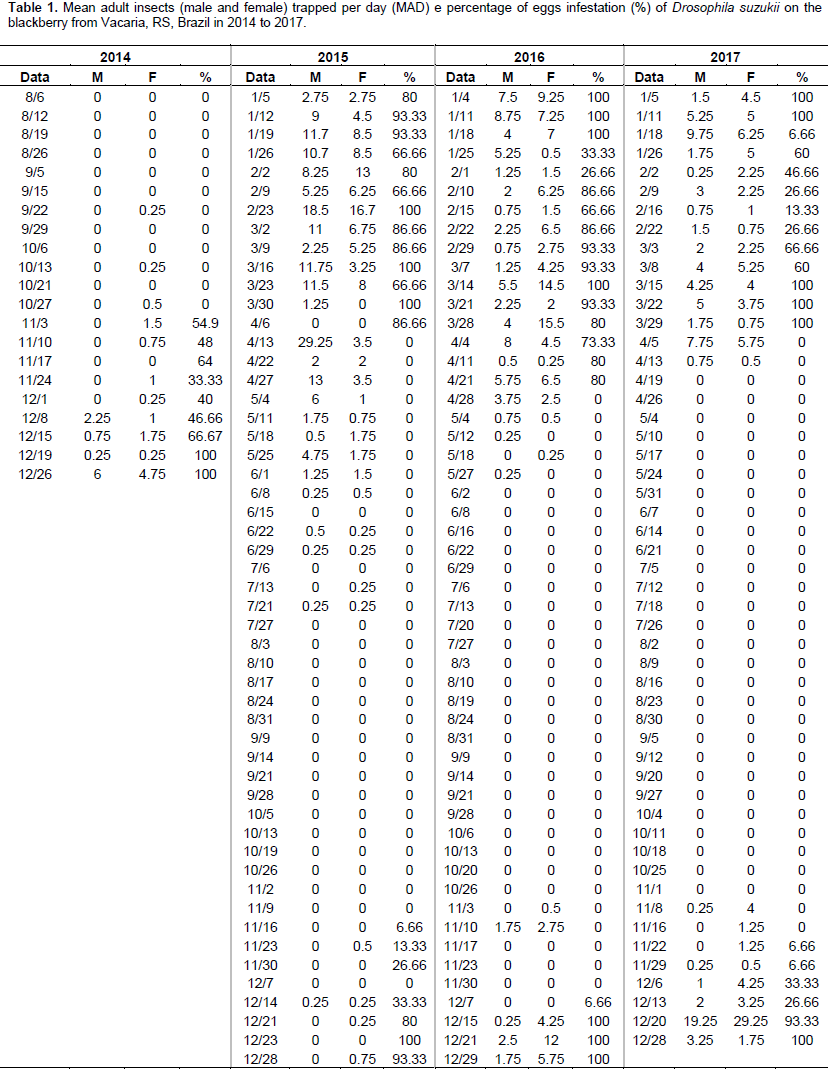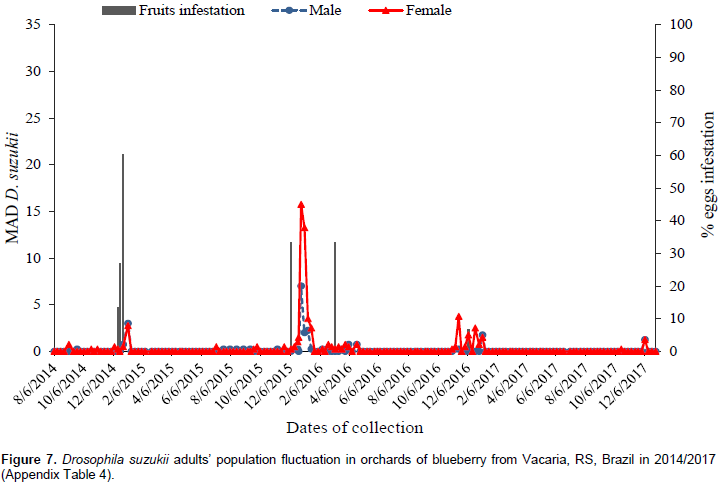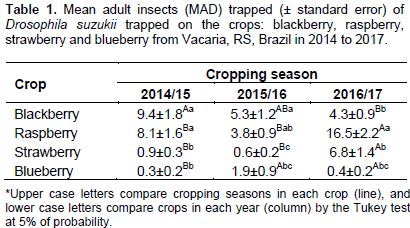ABSTRACT
Drosophila suzukii is an insect pest with high capacity to cause damage to soft-skinned fruit whose behavior on host crops in Brazil is still unknown. This study aims to determine the population fluctuation of D. suzukii on different berry ¬¬¬¬¬¬crops from 2014 to 2017 and infestation. In each orchard, two traps containing attractant (biological yeast + sugar + water) were installed each week; and sorting was done in laboratory after two days hold-up period. At the same time, fruits were harvested to assess the presence of D. suzukii. The emergence of D. suzukii was observed in December (late spring), population increased from January to March (summer) and terminated in June (late fall). In the winter, there were no adults in the traps. The crop of blackberry was highly preferred in first two years, followed by raspberry and strawberry. In the third year, the preference was for raspberry. The blueberry is less attacked due to the asynchronization between the fruiting time and occurrence of the pest.
Key words: Spotted wing drosophila, blackberry, raspberry, blueberry, strawberry.
Drosophila suzukii (Matsumura, 1931) (Diptera, Drosophilidae) is a polyphagous quarantine pest (Cha et al., 2014) with elevated dispersion capacity, which cause damage in developing fruits. The registered species in 2008 was in several places in the United States, Canada and EU; they bring about elevated damage to various fruit crops (Hauser, 2011). In Brazil, the first registered occurrence was made at the Vacaria City Region, at Rio Grande do Sul State, (In Southern Brazil), with 30% of damaged fruits of strawberry (Santos, 2014). Worldwide, the insect pest is known as “Spotted Wing Drosophila (SWD)”, but in Brazil, the term “Suzuki” is used as the insect’s common name. This insect pest has a wide range of hosts, and attacks different fruit species including berry crops (Bolda et al., 2010; Goodhue et al., 2011). There are several records of significant damage in cherry, blackberry, raspberry, strawberry and blueberry (Lee et al., 2011; Walsh et al., 2011). In contrast to other Drosophila species, which prefer damaged fruits for oviposition, D. suzukii uses ripe fruits and its sclerotized serrated ovipositor is capable of puncturing the skin of straight fruits for oviposition (Lee et al., 2012; Wallingford et al., 2015). Burrack et al. (2017) reported that in USA, the insect pest has a pattern of preference for some crops and the synchrony between fruiting and the presence of the insect pest is a key factor for the management of D. suzukii. As the pest was identified in Brazil at only four years, there is a lack of information about the population aspects on host crops as well as the resulting damage. These aspects limit the preparation of control and management practices of this species in Brazil. Thus, the objective of this study is to determine the population fluctuation of D. suzukii on the crops of blackberry, raspberry, strawberry and blueberry to correlate the occurrence with fruit infestation with eggs.
The study was carried out in a commercial orchard with diverse berries production, located at the Vacaria city region, Rio Grande do Sul State, Brazil (28°28'41.95"S and 50°58'11.74"W) between August of 2014 and December of 2017. The assessed crops were blackberry (variety ‘Tupy’ and ‘Thompson’), and raspberry (variety ‘Heritage’) both crops grown in the soil, under plastic high tunnel cover; strawberry (variety ‘Albion’) grown into greenhouse and cropped on substrate, and blueberry (variety ‘O’Neal’ and ‘Duke’) grown under hail nets (Figure 1). For the study, each crop was considered as an experimental unit. In each crop, two traps were installed for monitoring. It was made from colorless Coca Cola™ plastic bottles (250-ml) previously washed with tap water and dried which contained five holes of 0.5 cm diameter; they were filled with a yeast based Sacharomyces spp., sugar and water as suggested by Santos (2016), for monitoring adults of D. suzukii (Figure 2). Traps were changed at weekly interval and placed at the intermediate position of the plant’s canopy (blackberry, raspberry and blueberry) and above the plants on strawberry, keeping for two days hold up period.

They were gathered for assessment at the Embrapa Uva and Vinho Entomologic Lab facilities, using a stereomicroscope with a 2-fold enhancement for insect identification and counting. At the time of trap collection, a sample of 15 fruits from each experimental unit was picked up randomly for the assessment of D. suzukii oviposition. The data were tabulated and the total average of adults trapped per day in each trap was calculated (symbolized in Brazil by MAD) from each monitoring trap. A pest population curve for each fruit crop was prepared throughout the experiment. The sex ratio was assessed using the total number of D. suzukii trapped during the study, in each crop, and subjected to the chi-square (χ2) test at 5% of probability. MAD and the percentage of eggs found in the fruits were used to determine the difference among crops and years. The data were subjected to analysis of variance and the means were sorted by the Tukey test at 5% of probability.
The total number of D. suzukii trapped in all sites was 8553 (4304 males and 4249 females) with no significant difference on the sexual proportion (χ2= 0.354; DF = 1; p = 0.5593), during the 177 evaluations. In general, female D. suzukii adults was seen constantly at late spring (November 2014), males being detected from December of that year. Trapping continued until June 2015. During the winter the pest was not detected; a new incidence occurred only during the following late spring (December 2015), following the same pattern as previous year, with trapping stopped in late October. The same behaviour was found in the subsequent years of the study (Figure 3). On the blackberry crop, throughout the experiment, 2724 individuals were entrapped (1346 males and 1378 females) without any significant difference between males and females (χ2 = 0.376; DF = 1; p = 0.5525). The presence of D. suzukii was first observed on September 22nd, 2014 when an insect was trapped at the experimental unit without the presence of developing fruits; but this did not happen in the subsequent years. The constant occurrence of the pest and elevated MAD at the site were registered from November 24th, 2014. The greater peak of females occurred in February 2nd, 2015 with 13 MAD, while for males, later, on April 13th, 2015 with 29.25 MAD. Adult entrapped individuals were registered until June 2015; they restarted activity in December 2015 until late of May 2016. The same pattern was repeated in 2017 (Figure 4, Appendix Table 1).



On the raspberry crop, 4376 individuals were trapped (2337 males and 2039 females) with significant difference on the sexual proportion (χ2 = 20,293; DF = 1; p = 0.0001). The trapping started in early December 2014 with peaks of males of 24.25 MAD in January 1st, 2015 and females of 8 MAD in March 2nd, 2015, ending the entrapments in June 2015. The presence of the insect pest was noticed again between December 2015 and May 2016 with the same pattern found in 2017 (Figure 5, Appendix Table 2). On the strawberry crop, 1037 individuals (506 males and 531 females) were trapped, without significant difference of the sexual proportion (χ2 = 83,163; DF = 1; p = 0.0001). The trapping of D. suzukii on the crop started in December 2014 although with decreased number of adults trapped, compared to blackberry and strawberry. The greatest records occurred in March 16th, 2015 when 4.25 males and 3.50 females (MAD) were trapped. The end occurred in April 2015. In the following years the fluctuations of D. suzukii followed the same pattern, but with elevation of the population in the year 2017 (Figure 6, Appendix Table 3). On the blueberry crop, 416 individuals were trapped (115 males and 301 females) with significant difference on the sexual proportion (χ2 = 37,59; DF = 1; p = 0.0001).




The population of D. suzukii remained below the level found for the other crops studied. The trapping started in December 2014 and ended in January 2015; it resumed in December 2015, when there was greater occurrence in the crop with 15.75 MAD of females in December 28th, 2015. In 2016 and 2017, the pattern of occurrence wasthe same (Figure 7, Appendix Table 4). On the assessed crops, blackberry, raspberry and strawberry, a similar trend in trap catches of D. suzukii start in early spring; was observed with higher numbers trapped throughout the summer, and then declined during winter, except blueberry, which started and ended during summer. The period of D. suzukii occurrence is in agreement with the records obtained from Europe and United Stated (Harris et al., 2014; Kinjo et al., 2014; Mazzetto et al., 2015; Aldea, 2015); it demonstrates a relation with temperature and availability of any food resource at the region. D. suzukii is a pest adapted to environments with mild temperatures at a range between 13.4 and 28.1ºC (Tochen et al., 2014). At the study’s region, there is suitable temperature for the species as pointed out by Benito et al. (2016) as a critical area for the establishment of the pest in Brazil, confirmed by this study. Burrack et al. (2017) stated that the D. suzukii infestation risk is also associated to seasonality of fruit production and the preference of the pest for the host plants.


In fact, the occurrence of adults in the traps was significantly greater on the raspberry crop in relation to strawberry and blueberry crops in the first and second years, and all crops in the third year of crop assessment (Table 1). On raspberry, it is possible to observe significant elevation on the occurrence of the pest in the third year of crop assessment (Table 1). Thus, the absence of D. suzukii during the winter may be related to the lack of host fruit crops apart from low temperatures. It is possible that during this period the insect pest could be in diapause, as related to other countries (Dalton et al., 2011; Walsh et al., 2011). The fruit infestation with D. suzukii eggs tailed the adult’s population fluctuation in all crops, and varied between 6 and 100% in blackberry, raspberry and strawberry. Blackberry presented the greatest number of sampling occasions (trap’s gathering) with 100% of attacked fruits (16.7, 16.7 and 26.7%) on the first, second and third cropping seasons, respectively. On raspberry and strawberry, the totality of infested fruits with eggs was only seen once in the third year of study.

The mean infestation percentage in blackberry varied between 37.1 and 55.3% being statistically superior to the other crops in the first two years, and similar to what was found in raspberry and strawberry crops in the third year (Table 2). On raspberry, the percentage varied from 28.1 to 37.1% with significant elevation in the third year of study (Table 2). The same behaviour of significant elevation of fruit infestation was verified with the strawberry crop, where the percentages varied from 15.3 to 28.7%. On blueberry crop, the infestation was low and statistically similar in the three years of study (Table 2). The period of crop’s fruiting of the assessed crops at the study’s region: blackberry (December to March), raspberry (December to May), blueberry (December to January) and strawberry (December to May) are linked to the period of incidence of the pest in the orchards. The staggered host fruit supply and the insect’s preference guided the population dynamics at the studied area, where there is a clear dispersion among crops. Based on the collected populations and the eggs infestations, the pest preference for blackberry and raspberry in Southern Brazil is outstanding.

Although reports from overseas point out the preference of D. suzukii to raspberry crop, Aldea (2015) in Spain observed greater population and damage caused by the pest in raspberry, and little damage in strawberry. In the United States, Burrack et al. (2013) host preference tests were performed in laboratory with raspberry, blackberry, strawberry and blueberry where greater oviposition was found in raspberry and little oviposition in blueberry. In the present study, strawberry seemed not to be the preferential host crop for D. suzukii when other host crops are available around the cropping site, although in places with exclusive strawberry production the losses might be significant, as reported by Santos (2014) in Vacaria, RS. The lower infestation level at the blueberry crop in this study is related to the variety of fruit species grown closely in the same area, which results in low infestation of D. suzukii. The variety O’Neal (southern highbush) is considered as precocious at the study’s region, and the ripening of fruits occurring until December, but for the variety Duke (highbush) classified as late-bearing variety produces until January (Pagot, 2006). The fact is its’ fruiting period and harvesting happens when D. suzukii is with reduced populations and beginning of infestation, making these varieties to bypass the attack from the study’s region. For other crops and places this aspect has been related; for example, strawberry in the United States reportedly has low D. suzukii damage due to asynchrony between fruit production and the presence of the pest (Burrack et al., 2017).
The occurrence of D. suzukii in Southern Brazil is related to the availability of yielding host fruits which start at late spring and end on late fall, without winter. The fruit infestation with D. suzukii eggs tails the adults’ population fluctuation on the host crops, and might reach 100%. In the presence of many host crops cultivated closely in an area, the preferred crops by D. suzukii are blackberry and raspberry, followed by strawberry. Among the Blackberry and raspberry crops there was inversion of adults occurrence along the years, higher for blackberry in 2014/15 and 2015/16, and raspberry in 2016/17. The attack on the blueberry crop is little in early and mid-bearing varieties due to lack of synchrony between the occurrence of the pest and fruit production.
The authors have not declared any conflict of interests.
The authors are grateful to the interns of the Entomology Laboratory of the Embrapa Uva e Vinho: Lucas de Almeida Bizotto, Anelise de Oliveira, Gabriel Fedozi Furlani and Alexander Rodrigues Pereira for their contribution towards the screening of D. suzukii.
REFERENCES
|
Aldea PA (2015). Situación actual de Drosophila suzukii en la provincia de Huelva. Medidas de control. La Revista Profesional de Sanidad Vegetal 269:51-55.
|
|
|
|
Benito NP, Lopes-Da-Silva M, Santos RSS (2016). Potential spread and economic impact of invasive Drosophila suzukii in Brazil, Pesqui. Agropecu. Bras. 51(5):571-578.
Crossref
|
|
|
|
Bolda MP, Goodhue RE, Zalom FG (2010). Spotted wing drosophila: potential economic impact of a newly established pest. Agric. Resour. Econ. 13:5-8.
|
|
|
|
Burrack HJ, Abrieux A, Chiu J, Kent D, Diepenbrock L, Gut L, Isaacs R, Kirkpatrick D, Loeb G, Rodriguez-Saona C, Sial A, Swoboda-Bhattarai K, Walton V (2017). Drosophila suzukii status, biology, and management in the United States. In: IX SEMINÁRIO BRASILEIRO SOBRE PEQUENAS FRUTAS, 2017, Vacaria. Anais. Vacaria, RS: Embrapa, P 1.
|
|
|
|
Burrack HJ, Fernandez GE, Spiveyc T, Krausa DA (2013). Variation in selection and utilization of host crops in the field and laboratory by Drosophila suzukii Matsumara (Diptera: Drosophilidae), an invasive frugivore. Pest Manage. Sci. 69(10):1173-80.
Crossref
|
|
|
|
Cha DH, Adams T, Werle CT, Sampson BJ, Adamczyk JJ, Rogg H, Landolt PJ (2014). A four-component synthetic attractant for Drosophila suzukii (Diptera: Drosophilidae) isolated from fermented bait headspace. Pest Manage. Sci. 70:324-331.
Crossref
|
|
|
|
Dalton PT, Walton VM, Shearer PW, Walsh D, Caprile J, Isaacs R (2011). Laboratory survival of Drosophila suzukii under simulated winter conditions of the Pacific Northwest and seasonal field trapping in five primary regions of small and stone fruit production in the United States. Pest Manage. Sci. 67(11):1368-1374.
Crossref
|
|
|
|
Goodhue RE, Bolda M, Farnsworth D, Williams JC, Zalom FG (2011). Spotted wing drosophila infestation of California strawberries and raspberries: economic analysis of potential revenue losses and control costs. Pest Manage. Sci. 67:1396-1402.
Crossref
|
|
|
|
Harris DW, Hamby KA, Wilson HE, Zalom FG (2014). Seasonal monitoring of Drosophila suzukii (Diptera: Drosophilidae) in a mixed fruit production system. J. Asia-Pacific Entomol. 17:857-864.
Crossref
|
|
|
|
Hauser M (2011). A historic account of the invasion of Drosophila suzukii (Matsumura) (Diptera: Drosophilidae) in the continental United States, with remarks on their identification. Pest Manage. Sci. 67:1352-1357.
Crossref
|
|
|
|
Kinjo H, Kunimi Y, Nakai M (2014). Effects of temperature on reproduction and development of Drosophila suzukii (Diptera: Drosophilidae). Appl. Entomol. Zool. 49(2):297-304.
Crossref
|
|
|
|
Lee JC, Bruck DJ, Dreves AJ, Ioriatti C, Vogt H, Baufeld P (2011). In focus: Spotted wing drosophila, Drosophila suzukii, across perspectives. Pest Manag. Sci. 67:1349-1351.
Crossref
|
|
|
|
Lee JC, Burrack HJ, Barrantes LD, Beers EH, Dreves AJ, Hamby KA, Haviland DR, Isaacs R, Richardson TA, Shearer PW, Stanley CA, Walsh, DB, Walton VM, Zalom FG, Bruck DJ (2012). Evaluation of Monitoring Traps for Drosophila suzukii (Diptera: Drosophilidae) in North America. J. Econ. Entomol. 105:1350–1357.
Crossref
|
|
|
|
Mazzetto F, Pansa MG, Ingegno BL, Tavella L, Alma A (2015). Monitoring of the exotic fly Drosophila suzukii in stone, pome and soft fruit orchards in NW Italy. J. Asia-Pacific Entomol. 18:321-329.
Crossref
|
|
|
|
Pagot E (2006). Cultivo de pequenas frutas: amora-preta, framboesa, mirtilo. Emater/RS-Ascar Porto Alegre 41 p.
|
|
|
|
Wallingford AK, Hesler SP, Chaa DH, Loeba GM (2015). Behavioral response of spotted-wing drosophila, Drosophila suzukii Matsumura, to aversive odors and a potential oviposition deterrent in the field. Pest Manag. Sci. 72:701-706.
Crossref
|
|
|
|
Santos RSS (2014). Ocorrência de Drosophila suzukii (Matsumura, 1931) (Diptera: Drosophilidae) atacando frutos de morango no Brasil. Embrapa Uva e Vinho, Bento Gonçalves, Brazil. (Comunicado Técnico 159). Enciclopédia Biosfera 10(18):4005-4011.
|
|
|
|
Santos RSS (2016). Drosophila suzukii – Ocorrência e aspectos populacionais no morango, Revista Campo e Negócios. Access in: 20 jun.
View
|
|
|
|
Tochen S, Dalton DT, Wiman N, Hamm C, Shearer PW, Walton VM (2014). Temperature related development and population parameters for Drosophila suzukii (Diptera: Drosophilidae) on cherry and blueberry. Environ. Entomol. 43:501-510.
Crossref
|
|
|
|
Walsh DB, Bolda MP, Goodhue RE, Dreves AJ, Lee JC, Bruck DJ, Walton VM, O'neal SD, Zalom FG (2011). Drosophila suzukii (Diptera: Drosophilidae): invasive pest of ripening soft fruit expanding its geographic range and damage potential. J. Integr. Pest Manage. 1:1-7.
Crossref
|